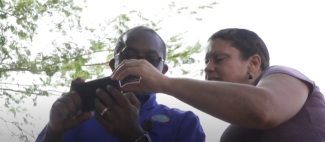Jamaica lies within the Atlantic hurricane belt, making it susceptible to devastating damage that these storms often leave behind. However, the pendulum swings from one extreme to another when it comes to weather: heavy rainfall to severe drought.
Between 2014 and 2015, Jamaica experienced one of the worst seasons of drought in recent history. The impact on the Jamaican economy, especially rural livelihoods, was devastating. According to reports, the annual agricultural production declined by 30 percent from 2013 to 2014. This, along with brush fires, resulted in a $J1 billion ($6.5 million) loss for the economy.
According to the Statistical Institute (STATIN) report, the agriculture sector constitutes between 7 and 14 percent of the country’s Gross Domestic Product (GDP) and almost one fifth of the employed labor force. The importance of agriculture to Jamaica’s economy, coupled with the country’s sensitivity to the effects of climate change and severe weather events, leads to a domino effect. Not only do crops suffer, but farmers lose resources and income, while local production and consumption are severely impacted.
This devastating drought highlights how climate change not only impacts the environment, but also countries’ economies and families.
Recognizing the need to address the impact of the drought on Jamaica’s economic development, USAID collaborated with the Jamaican Meteorological Service (JMS) and the International Research Institute for Climate and Society (IRI) to produce a new seasonal drought-related forecast tool. This tool is a forecast model that can predict in advance whether or not there will be a drought. These predictions can be done three, six or 12 months in advance. The tool uses rainfall data and sea surface temperatures to find correlations from year to year in order to arrive at the best forecast for drought.
“Promoting climate action and resilience to environmental shocks is critical to sustainable development,” explained Malden Miller, a Caribbean Regional Environmental Specialist at USAID. “This tool is a great example of how, with funding and technical assistance from USAID and collaboration from partner governments, we can make real change.”
This computer model forecast system gives farmers the ability to adjust planting and harvesting schedules to preserve crops, protect investments and, ultimately, help increase farmer incomes.
In 2015, JMS, along with the Jamaican Rural Agricultural Development Authority (RADA), provided a pilot version forecasting tool to over 300 farmers through farmer forums, text messages, and extension agents. Farmers began receiving critical weather and climate information, allowing farmers to make decisions, like when to plant crops and the best time to fertilize. The Jamaican Ministry of Agriculture and Fisheries also sends alerts to warn farmers about pest and disease outbreaks based on the weather information.
What happened next was astounding: Within a year, usage of this drought prediction tool spread from Jamaica to across the Caribbean and Central America, assisting more than 40 million people in the region.
Still Standing Strong
Seven years later, the use of the drought prediction tool has expanded globally.
“The tool is now being widely used in the Caribbean, Central America, Africa and Asia. The World Meteorological Organization has also adopted the tool, and a training manual was developed subsequently to its development,” notes Glenroy Brown, a scientist at JMS.
Since 2015, the drought-related forecast tool continues to expand its global reach and its capabilities. The tool is now a part of the JMS Common Alerting Protocol (CAP) system, a digital platform for exchanging emergency weather and climate alert messages, which are disseminated simultaneously over multiple communications channels to end users. In addition, the Government of Jamaica has incorporated the tool into its National Disaster Committee plans, and a future national drought plan will include data from the tool.
“Taking a proactive approach is essential to mitigating the threats of climate change; merely responding to hurricanes is not enough. The drought-related forecast tool is one example where USAID support has strengthened the capacity of the Caribbean people so that they are more resilient in the face of natural disasters and can reduce the risks associated with climate variability,” shared Malden Miller.
Farmers locally and globally continue to apply the tool to their practices and livelihoods with great success.
“I think this is one of the best things to have happened to the coffee farmer. We are really grateful for USAID’s efforts in helping us better predict the weather conditions and make decisions,” said Noel Hibbert, a coffee farmer from Penlyne Castle, St. Thomas.
Increasing Access
While the drought-related forecast tool was created specifically for farmers, JMS recognizes that climate change impacts more than just farmers and is looking to expand the tool’s capabilities even further.
“Climate change and drought affect various sectors. Currently, JMS is partnering with the fishery sector to design a similar platform for fishers and operators of fish ponds. The tool is also now being used in conjunction with a newly developed bushfire early warning tool to assist farmers and communities that are prone to bushfires,” said Glenroy.
The ultimate goal of the drought-related forecast tool is to develop an easily accessible mobile phone application.
“Our intention for the app is to give turn-by-turn weather and climate information based on one’s location across the island, not just in the agricultural sector, but for all government agencies and users of weather and climate data in Jamaica,” added Glenroy.
Building this forecasting tool has resulted in building resilience in Jamaica and globally.
“For years, USAID has worked with Jamaica to help its citizens recover from hurricanes, droughts, and other natural disasters,” said Miller. “While emergency response is a part of USAID’s mission, we’re proud to work with countries to build resilience to future extreme weather events.”
About the Author
Kimberley Weller is the Development Outreach and Communications Specialist for USAID’s Mission in Jamaica.

Photo Courtesy of Glenroy Brown
